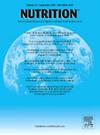Association between the inflammatory potential of diet and chronic renal failure: A cohort study of 163 433 UK Biobank participants
IF 3.2
3区 医学
Q2 NUTRITION & DIETETICS
引用次数: 0
Abstract
Objectives
There is some preclinical evidence suggesting a pro-inflammatory diet reduces kidney function. In the present study, we aimed to investigate the association of inflammatory potential of diet with the risk of chronic renal failure (CRF).
Methods
Cox regression models were used to examine the association between the energy-adjusted dietary inflammation index (E-DII) quartiles and CRF adjusting varying degrees of confounders. Restricted cubic spline regression was additionally adopted to determine the association of the continuous E-DII and CRF risk. A series of sensitivity and subgroup analyses were also conducted.
Results
A total of 163,433 participants entered the primary analysis. During a mean follow-up period of 12.65 years, incident CRF occurred in 5, 333 participants (3.26%). The E-DII scores was stratified into four quartile groups. In a fully adjusted multivariable model, the adjusted hazard ratio for the second, third, and highest quartiles of E-DII intake was 1.12 (95% confidence interval [CI]: 1.04–1.21), 1.21 (95% CI: 1.12–1.31), and 1.23 (95% CI: 1.14–1.33), respectively, compared with the lowest quartile. Trend test indicated a statistically significant increasing trend with increasing E-DII quartiles (P < 0.0001). Similarly, restricted cubic spline regression displayed a positive association of continuous E-DII with CRF, wherein higher scores were linked to an elevated risk of CRF. Results of sensitivity analyses demonstrated consistent findings.
Conclusions
Diet with higher proinflammatory potential was linked to an increased risk of CRF. Implementing measures to limit the intake of pro-inflammatory foods or promoting the adoption of an anti-inflammatory dietary pattern could potentially reduce the occurrence of CRF.
饮食炎症潜能与慢性肾衰竭之间的关系:一项163,433名英国生物银行参与者的队列研究
目的:有一些临床前证据表明,促炎饮食会降低肾功能。在本研究中,我们旨在探讨饮食的炎症潜力与慢性肾功能衰竭(CRF)风险的关系。方法采用scox回归模型检验能量调整饮食炎症指数(E-DII)四分位数与调整不同混杂因素程度的CRF之间的关系。另外采用限制性三次样条回归来确定连续E-DII与CRF风险的关系。还进行了一系列敏感性和亚组分析。结果共有163,433名参与者进入初步分析。在平均12.65年的随访期间,5333名参与者(3.26%)发生了CRF事件。E-DII评分分为四个四分位数组。在一个完全调整的多变量模型中,与最低四分位数相比,第二、第三和最高四分位数E-DII摄入量的调整风险比分别为1.12(95%可信区间[CI]: 1.04-1.21)、1.21 (95% CI: 1.12 - 1.31)和1.23 (95% CI: 1.14-1.33)。趋势检验表明,随着E-DII四分位数的增加,其增加趋势具有统计学意义(P <;0.0001)。同样,限制性三次样条回归显示连续E-DII与CRF呈正相关,其中较高的评分与CRF风险升高有关。敏感性分析的结果显示了一致的结果。结论:具有较高促炎潜力的饮食与CRF风险增加有关。采取措施限制促炎食物的摄入或促进采用抗炎饮食模式可能会减少CRF的发生。
本文章由计算机程序翻译,如有差异,请以英文原文为准。
求助全文
约1分钟内获得全文
求助全文
来源期刊

Nutrition
医学-营养学
CiteScore
7.80
自引率
2.30%
发文量
300
审稿时长
60 days
期刊介绍:
Nutrition has an open access mirror journal Nutrition: X, sharing the same aims and scope, editorial team, submission system and rigorous peer review.
Founded by Michael M. Meguid in the early 1980''s, Nutrition presents advances in nutrition research and science, informs its readers on new and advancing technologies and data in clinical nutrition practice, encourages the application of outcomes research and meta-analyses to problems in patient-related nutrition; and seeks to help clarify and set the research, policy and practice agenda for nutrition science to enhance human well-being in the years ahead.
 求助内容:
求助内容: 应助结果提醒方式:
应助结果提醒方式:


